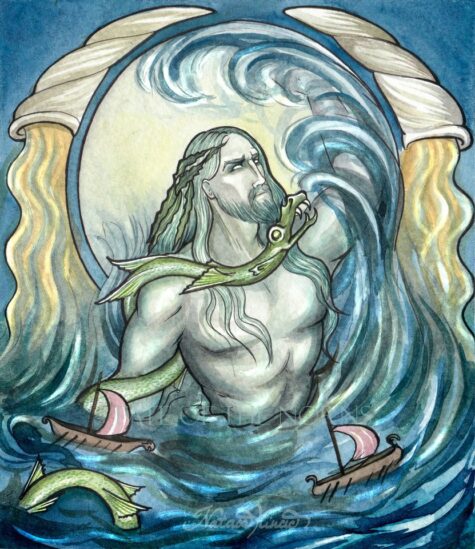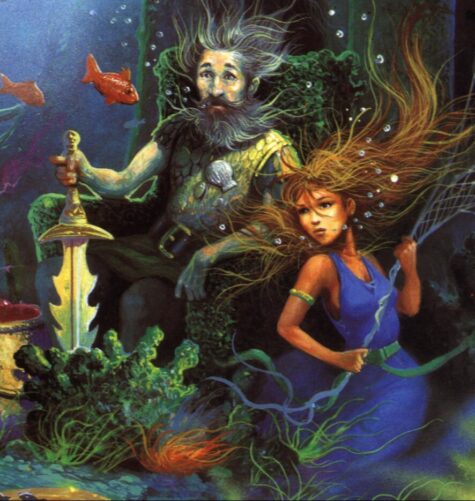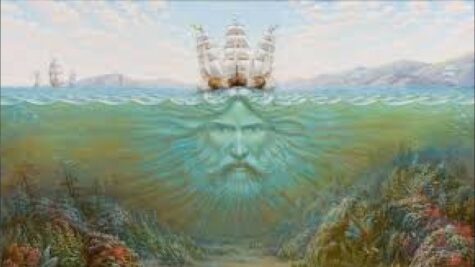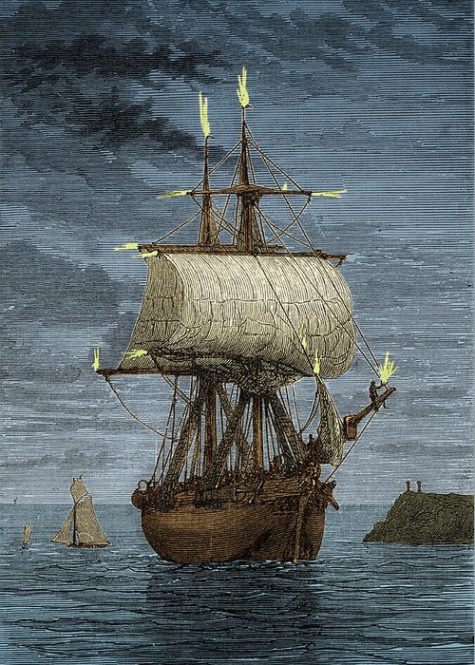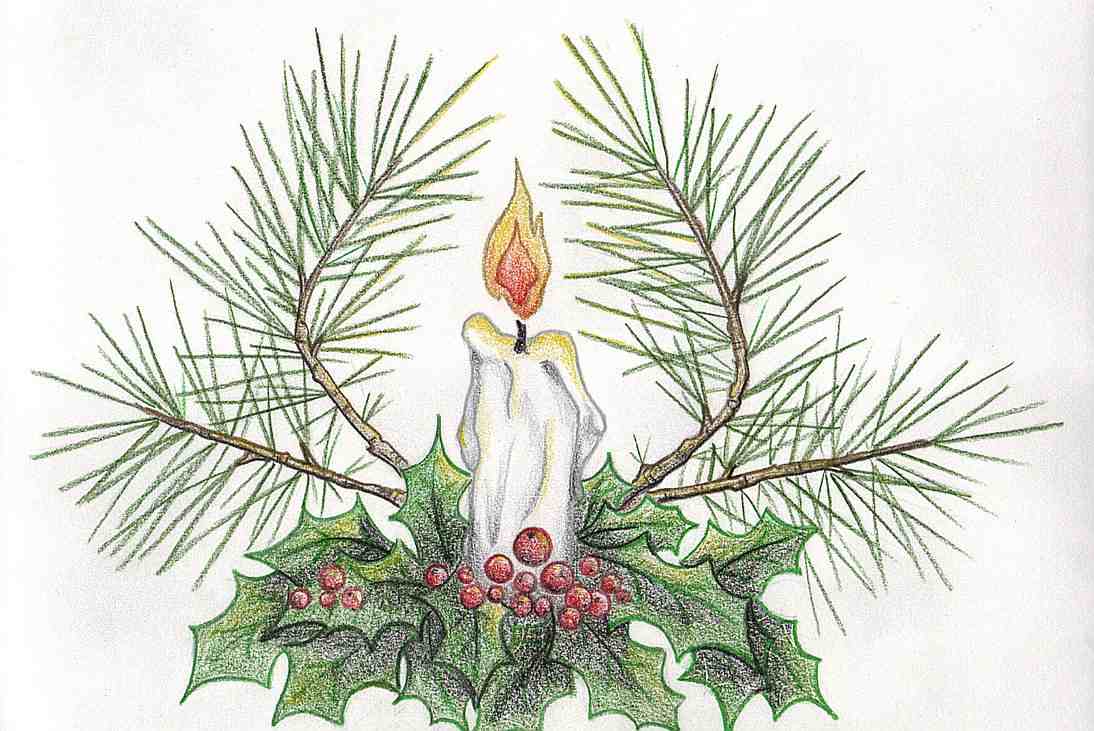Sailing
According to some calendars, March 3rd is Aegir’s Day, this has also been referred to as the Celtic Sea Festival. The Pagan Book of Hours has a day for Aegir and Ran listed as July 25.
Ægir or Aegir is a Norse sea jötunn, a mythological giant (sometimes called a Frost Giant) and God of the sea. He’s also the brewer to the gods of Asgard. Aegir is also a God of brewing known for the beer he brewed in an enormous cauldron stolen from the giants by Thor and Loki. (Read that story here: Aegir’s Feast.)
He hosted elaborate parties, providing home-brewed ale in enormous pots. His mugs would magically refill themselves with more ale.
Married to the goddess Ran, they have nine daughters who each personify different kinds of waves.
Party and Celebration Ideas
To celebrate, have a party with a local microbrew and smørrebrød.
Roast Beef & Pickle Smørrebrød
- 1 slice rye bread, crust trimmed off
- 1/2 teaspoon unsalted butter, slightly softened
- 1/8 lb. sliced roast beef, cut into squares
- 2 to 4 cornichons (gherkins), thinly sliced lengthwise
- fried onions, (recipe below)
- 1 teaspoon prepared horseradish
Spread bread evenly with butter. Arrange roast beef on butter. Arrange cornichons and onion on top. Top with a dollop of horseradish.
Fried Onions
- Thinly slice a white onion.
- Soak in cold water for 10 minutes.
- Drain, then dredge onion in flour.
- Fry in hot oil until golden brown.
Ceremony for the Day of Aegir and Ran
- Date: July 25 – also known as 25 Haymonath
- Colors: Sea-blue, sea-green.
- Element: Water
- Offerings: Singing. Blood given to the ocean. Aid those who clean the seas.
- Song: Harp Song of the Dane Women, along with any other sea songs, sung as offerings.
- Daily Meal: Seafood.
Altar:
Upon cloth colored like the sea place shells, nets, figures of fish, sea floats, and anything that comes from the sea. Place there also a cup of wine with flecks of gold in it.
Invocation to Aegir, Ran, and the Nine Sisters
Lord and Lady of the Depths,
Keepers of the great flocks and herds
That float by the millions
Through glass-green waves,
Lady Ran of the ten-times-fingering weed,
Your hair spread throughout the worlds,
Lord Aegir of the great currents
And the waves that keep the ship afloat,
Generous in your bounty,
Capricious in your favor,
Brewer of ale for gods and lost souls,
Keep us safe as we pass over your realm
In life, in dreams, and in mystery.
Nine Sisters of the Waves, Sacred Undines,
Daughters of Aegir and Ran, fish-tailed,
Blood on your hands and beauty in your song,
We hail you from the shores, the depths, the heights of sea-cliffs.
Kolga the Cold One, Ice-Maiden of the floes and castles.
Duva the Hidden One, Keeper of island treasures.
Blodughadda, Blood-Haired One, shark’s delight.
Hronn, Sucking Whirlpool, Eel-daughter and Mistress of Fear.
Hevring, Heaving Storm, Mourning’s Mistress.
Bara, Great Wave of the Whale, battering the land’s stalwart stand.
Bylgja, Breaker’s Dancer, Rider of the Wave-Horse.
Unn, Billowing Tides, Maiden of the Counting Moon’s Rhythm.
Himinglava, Fair-Weather Mermaid, Sun Shining Through.
Teach us by the Powers of Water
How to find the way to our own souls.
Petitioning Aegir
Aegir is the presiding spirit of the ocean. He may also be understood as actually being the ocean. This ancient deity is beloved but feared. Petition him for safety on the seas and to reveal the secrets of the deep. Aegir knows everything. He is a well of knowledge and can theoretically fill any request or recruit another deity who can.
Petitions should always be accompanied with offerings. An altar may be built for him, or offerings may be brought to the sea. Be generous. He’s a king.
Give him objects reminiscent of the sea. Give him fine old coins – sailors once carried them so that in case they drowned, they wouldn’t arrive at Aegir’s hall empty handed. Serve him mead and ale, acknowledging that you know it’s nowhere near as good as what he serves at home.
Aegir – The Moon
Aegir, originally called S/2004 S10, is a natural satellite of Saturn. Its discovery was announced on May 4, 2005, from observations taken between December 12, 2004, and March 11, 2005.
Aegir is a member of the Norse group of moons. These “irregular” moons have retrograde orbits around Saturn—traveling around in the opposite direction from the planet’s rotation. Aegir and the other Norse moons also have eccentric orbits, meaning they are more elongated than circular.
Like Saturn’s other irregular moons, Aegir is thought to be an object that was captured by Saturn’s gravity, rather than having accreted from the dusty disk that surrounded the newly formed planet as the regular moons are thought to have done.
Aegir is about 6 kilometres in diameter, and orbits Saturn at an average distance of 19,618 Mm in 1025.908 days, at an inclination of 167° to the ecliptic (140° to Saturn’s equator), in a retrograde direction and with an eccentricity of 0.237.
The moon was named in April 2007 after Ægir, a giant from Norse mythology, the personification of tranquil seas, the one who soothes storms away. He is a son of Fornjót, and brother of Logi (fire, flame) and Kári (wind).
The name may be pronounced various ways. /ˈaɪjɪər/ (with the ‘g’ pronounced as a y-sound) approximates modern Norwegian and Icelandic. /ˈæɡɪər/ (with a hard ‘g’) approximates what the Old Norse may have sounded like, while the Latinized/spelling pronunciations /ˈiːdʒɪər/, /ˈɛdʒɪər/ and /ˈeɪdʒɪər/ are also found.
Aegir – the Tidal Bore
Aegir also gives his name to the tidal bore on the river Trent (in England) which is particularly powerful around the equinoxes. At certain times of the year, it is possible to see a bore of up to five feet high.
Aegir is said to rush up the river to try and reclaim the surrounding land and expand his watery kingdom.
The Trent Aegir is also known as the Eagre. The Aegir occurs when a high spring tide meets the downstream flow of the river forcing it back and causing a wave to flow upstream. Typically it is possible to see the bore from Derrythorpe to as far up the river as Gainsborough. Beyond Gainsborough the bore is reduced to a ripple.
The best places to see the Aegir are at Gainsborough, Morton, East Stockwith, West Stockwith and Owston Ferry.
The tidal bore is notoriously difficult to predict as there are several factors involved in its appearance but the Crowle Community Forum at Crowle.org does have an Aegir timetable which you can check out. (2021 predictions)
Sources:
The 2nd of June is St Erasmus of Formia’s day – better known as St Elmo. He is said to have kept preaching during a thunderstorm and even when lightning struck near him. Sailors therefore look on the electrical discharges that hit masts or other protuberances as a sign that the saint is watching over them, and call this St Elmo’s Fire.
St. Elmo’s fire is a bright blue or violet glow, appearing like fire in some circumstances, from tall, sharply pointed structures such as lightning rods, masts, spires and chimneys, and on aircraft wings or nose cones. St. Elmo’s fire can also appear on leaves and grass, and even at the tips of cattle horns. Often accompanying the glow is a distinct hissing or buzzing sound. It is sometimes confused with ball lightning.
Invoking Saint Erasmus
In addition to being the patron saint of sailors, Saint Erasmus is also the patron saint of a host of other groups, including explosives workers, ordnance workers, and women in labor. He is also invoked against colic, birth pains, intestinal disorders, stomach diseases, and storms. He is one of the Fourteen Holy Helpers, a group of saints regarded as special protectors against various illnesses.
Invocation of St. Erasmus
Holy martyr Erasmus, who didst willingly and bravely bear the trials and sufferings of life, and by thy charity didst console many fellow-sufferers; I implore thee to remember me in my needs and to intercede for me with God. Staunch confessor of the Faith, victorious vanquisher of all tortures, pray Jesus for me and ask Him to grant me the grace to live and die in the Faith through which thou didst obtain the crown of glory. Amen.
Account of His Life and Martyrdom
Erasmus was Bishop of Formia, Italy. During the persecution against Christians under the emperors Diocletian (284-305) and Maximian Hercules (284-305), he left his diocese and went to Mount Libanus, where he hid for seven years. However, an angel is said to have appeared to him, and counseled him to return to his city.
On the way, he encountered some soldiers who questioned him. Erasmus admitted that he was a Christian and they brought him to trial at Antioch before the emperor Diocletian. After suffering terrible tortures, he was bound with chains and thrown into prison, but an angel appeared and helped him escape.
He passed through Lycia, where he raised up the son of an illustrious citizen. This resulted in a number of baptisms, which drew the attention of the Western Roman Emperor Maximian who, according to Voragine, was “much worse than was Diocletian.” Maximian ordered his arrest and Erasmus continued to confess his faith. They forced him to go to a temple of the idol, but along the saint’s route all the idols fell and were destroyed, and from the temple there came fire which fell upon many of the pagans.
That made the emperor so angry he had Erasmus enclosed in a barrel full of protruding spikes, and the barrel was rolled down a hill. But an angel healed him. Further tortures ensued.
When he was recaptured, he was brought before the emperor and beaten and whipped, then coated with pitch and set alight (as Christians had been in Nero’s games), and still he survived. Thrown into prison with the intention of letting him die of starvation, St Erasmus managed to escape.
He was recaptured and tortured some more in the Roman province of Illyricum, after boldly preaching and converting numerous pagans to Christianity. Finally, according to this version of his death, his stomach was slit open and his intestines wound around a windlass. This version may have developed from interpreting an icon that showed him with a windlass, signifying his patronage of sailors.
Sources:
A-ma is the patroness of all fishers and sailors in the region of Macao, where today (April 9) is her festival day and her birthday. Also sometimes called Matsu, this divine figure offers safety in any of life’s literal or figurative storms, often by teaching magical weather charms. Legend says that A-ma achieved enlightenment and a mastery of magic at the young age of 28, after which she went to Nirvana and became a Goddess.
- Themes: Water; Providence; Protection; Magick; Weather
- Symbols: Fish; Red cloth
To Do Today:
In Portugal, the day is spent enjoying parades for the goddess, eating lots of seafood, adorning altars with food and incense, and setting off firecrackers in A-ma’s honor. So by all means, have some type of fish today (if you’re allergic, eat fish-shaped candy instead). Before eating it, thank the founder of your feast with this prayer:
A-ma thank you for your providence and protection.
Let the seas of my soul find solace in you;
Let the waters of my spirit be refreshed in you. So be it.
Wear any red-colored clothing today to commemorate A-ma’s birthday and inspire her magical assistance. Ties or scarves are especially nice for this, as you can bind one of A-ma’s attributes within the knot for the day. Anything bearing a fish motif is also suitable.
From: 365 Goddess
